With the mobile being the dominant force in the current digital landscape, it is no longer a trend but a requirement to design using a mobile-first approach. This blog discusses how going mobile-first guarantees that your website will remain up-to-date, accessible, and user-friendly on every platform. From enhancing search engine rankings to optimizing user experience and keeping up with Google's mobile-first indexing requirements, mobile-first design keeps businesses ahead of the competition. Whether you are creating a new website or updating an existing one, to go mobile-first is the best approach to future-proof your online presence.

How Mobile-First Design Future-Proofs Your Website
How Mobile-First Design Future-Proofs Your Website
In an era where smartphones exceed the world's population and mobile traffic outpaces desktop traffic, mobile-first design is no longer a nicety—it's a strategic necessity. If your site isn't designed for mobile from the very beginning, you're not only missing out on traffic—you're putting your business's future at risk.
So what exactly is mobile-first design, and why is it the cornerstone of a future-proof online presence? Let's take a look.
What is Mobile-First Design?
Mobile-first design is creating your site or app with mobile devices as the initial platform, then incrementally improving it for wider screens such as tablets and desktops. Rather than retreading a desktop website onto smaller screens (which too often leads to bloated, clunky designs), mobile-first design begins small—with concentration, simplicity, and velocity.
Why Mobile-First is the Future (and the Present)
1. Mobile Usage is Dominant
More than 60% of global web traffic comes from mobile devices. Consumers are browsing, shopping, and engaging with content on the go. If your site isn’t delivering a seamless mobile experience, you’re turning users away.
2. Google Prioritizes Mobile
Since Google’s mobile-first indexing, the search engine primarily uses the mobile version of your site for indexing and ranking. A poor mobile experience directly affects your SEO performance, visibility, and discoverability.
3. Enhanced User Experience (UX)
A mobile-first website is faster to load, easier to navigate intuitively, and simpler to use with one hand. That converts into reduced bounce rates, increased session lengths, and better conversion rates—particularly crucial for e-commerce or lead generation sites.
4. Future-Ready Across Devices
By designing for the smallest screen first, you know your layout will scale effectively on every device—smartwatches, tablets, widescreen monitors. That makes your digital platform future-proofed.
5. Competitive Advantage
Companies that go mobile-first are ahead of the game. Your customers will remember how simple it was to use your site on their phone—and that great first impression can lead to loyalty and sales.
Mobile-First Principles
- Content First: Emphasize key content and features for small screens. Cut the fluff.
- Responsive Layouts: Employ adaptable grids and media queries to fit different screen sizes.
- Touch-Friendly Design: Make buttons tappable, menus accessible, and gestures supported.
- Fast Loading: Compress images, minify scripts, and utilize caching to improve speed.
- Minimalist Navigation: Streamline menus for one-handed use and readability.






